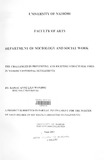| dc.description.abstract | Fire prevention and control are sometimes thought of as separate and apart from routine fire prevention activities that are carried out. There may be some justification for this if one thinks of fire losses in terms of property damage only. But fires carry a serious injury potential. Fires cause many serious injuries and deaths each year. Since this is the case, the prevention and control of fire should be a part of every community's program.
This study was designed to investigate the challenges in preventing and fighting structural fires in Nairobi's informal settlements. Specifically the study sought to: identify policy guidelines in Kenya and the extent to which they have been violated
within the informal settlement sector, establish the extent to which the violations of these guidelines lead to vulnerabilities to fire hazards in the informal settlements, assess the capacity of the community and other support systems to respond to fires, examine the mitigation and preparedness strategies that have been put in place.
Data was collected by use of both quantitative and qualitative methods with the interview as the main technique of gathering data. A total of 133 respondents were interviewed. They included 118 residents of the informal settlements, 10 fire officers from the Nairobi Fire brigade and 5 officials from the Kenya Red Cross Society. Descriptive statistics were used to analyse the data.
There were various reasons that the respondents cited as being the contributing factors to the rising cases of fire outbreaks in the informal settlements. These included stove explosions, improper installation of electricity, use of tin lamps, use of highly flammable
construction materials and use of charcoal burners.
The study established that despite the high cases of fire incidents in the informal settlements, the residents of the informal settlements did not have any fire preventive or response equipment installed in their houses and this was due to their low income levels. Among all the respondents only 17% had attended any fire drills and 97% of the respondents did not consider fire prevention a priority. This makes the residents of the informal settlements highly vulnerable to fires.
The study established that despite the high cases of fire incidents in the informal settlements, about 95% of the residents did not consider fire security to be an immediate
priority although important. Due to low incomes, fire incidents are considered as mere bad lack for which resources for prevention should not be spared. Lack of fire prevention measures really makes the informal settlements vulnerable to fire hazards.
The study established that there were various challenges that were faced when it came to preventing structural fires in Nairobi's informal settlements. These included the lack of a fire policy and a fire act that would give guidelines to the fire personnel on how to go about responding and fighting structural fires in the informal settlements. The fire act would also empower the fire personnel in enforcing fire regulations in the informal settlements. Another challenge was the lack of access to slum areas which hampered
effective employment of fire tenders whenever they reported to assist in controlling the fires.
There are various strategies that this study recommends to be put in place to help curb the rising cases of fire incidents in the informal settlements. These included holding of workshops and trainings on fire prevention and response in the informal settlements to make them fire resistant, enforcement of fire prevention regulations and building up of more and fully equipped fire stations.
In conclusion it is noted that disasters related to fire hazards is a problem that requires further study focusing on ways in which fires can be more effectively prevented through technological advances, construction techniques and improved inspection procedures. | en_US |

